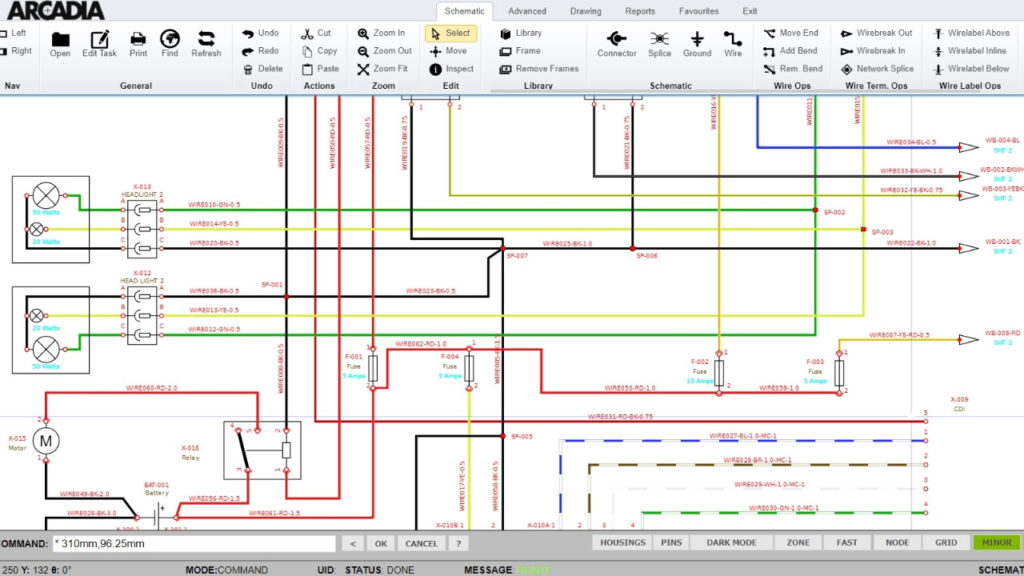The Role of Electrical Schematics Software in Modern Engineering

The Art of Schematic Design vs. the Power of Schematics Software
Manual drawings persist for a reason. Let’s examine why, and how it compares to free Computer Aided Design (CAD) software, before looking at advanced schematics software.
Manual drawings go beyond simply displaying connections and involve the concept of “signal flow.” This refers to the intended sequence or hierarchy of functions within the circuit. Free schematics software can handle basic layouts, but as complexity increases, the rules for signal flow become more nuanced. A skilled designer strategically positions components to visually represent:
● Simultaneous functions: Grouping elements performing actions at the same time enhances readability.
● Sequential processes: A logical flow from one stage to the next clarifies the order of operations.
This visual communication goes beyond basic connectivity. It ensures the future reader grasps the complete picture – where signals travel and their intended path within the system.
The Importance of Clarity: Schematics vs. Netlists
Multi-page schematics, as often seen with basic schematic CADs, rely solely on net names for connections. They force the reader to piece together the entire design across multiple pages, hindering comprehension. These are essentially glorified “netlists” – lists of connections without the crucial visual representation of flow and hierarchy.
A well-crafted schematic depicts each net as a single, unbroken line entering or exiting the page only once. This allows the reader to confidently trace the signal path, ensuring no critical details are missed.
Free Software’s Limitations: Grouping for Functionality
Basic software can automate single net tracing, but replicating a skilled designer’s ability to group components based on their functional relationships is a significant challenge. This strategic grouping visually conveys the underlying functionality of the circuit, making it easier to understand.
Manually prepared schematics remain valuable because they effectively communicate not just connections, but also the intended flow and hierarchy of functions within a circuit.
The Drawbacks to Manual Drawings
Time is money, as the saying goes. And the entire design process becomes more time-consuming without advanced schematics software. Creating schematics from scratch, including symbol drawing, wire routing, and manual annotation, pales in comparison to the speed of using pre-built libraries and automation features found in the best schematics software. Let’s take a closer look:
- Increased Risk of Errors
Manual drafting is prone to human error. Mistakes in symbols, connections, or wire labeling can easily occur and might not be caught until later stages, leading to costly rework.
- Reduced Efficiency
The entire design process becomes more time-consuming. Creating schematics from scratch, including symbol drawing, wire routing, and manual annotation takes significantly longer compared to using pre-built libraries and automation features found in software.
- Difficulty in Managing Complexity
As projects grow more intricate, with numerous components and interconnections, manual drawings become cumbersome and hard to manage. Visual clarity can be compromised, making it difficult to understand the overall system and identify potential problems.
- Limited Collaboration and Communication
Sharing and explaining manual drawings can be challenging. Lack of standardized symbols and potential inconsistencies can lead to confusion for colleagues working on the project.
- Challenges in Design Refinement and Iteration
Making changes to a manual drawing can be a tedious process, requiring erasing, redrawing, and potentially re-doing annotations. This discourages exploration of alternative designs and iterative improvements.
- Difficulties in Documentation and Maintenance
Maintaining accurate and up-to-date paper schematics over time becomes a burden. Integrating changes and revisions becomes cumbersome, potentially leading to confusion during troubleshooting or future modifications.
- Missed Opportunities for Innovation
The absence of simulation tools, often found within schematics software, restricts engineers from virtually testing and refining designs before building prototypes. This limitation can stifle exploration of creative solutions and optimization of a system’s performance.
The Advantages of Advanced Electrical Schematic Software
Electrical schematics software plays a central role in engineering, acting as a vital bridge between conception and realization. This is particularly true when dealing with increasingly intricate electrical systems and projects. The significance of schematics software lies in its ability to enhance:
- Design Accuracy
Schematic drawing software offers vast libraries of standardized symbols, ensuring consistent representation of electrical components. This reduces ambiguity and errors compared to manual drafting. Built-in simulation tools empower you to virtually test your circuit under different scenarios, verifying its functionality and performance before actually building it. This proactive approach helps ensure your design meets specifications.
You can also create custom components with precise specifications when standard libraries lack specific elements. This ensures accuracy in pin definitions and eliminates rework, as you can seamlessly reuse these custom components in future designs.
The software’s benefits extend beyond creation. It generates comprehensive reports that document your circuit. These reports become valuable resources for engineers troubleshooting the physical harness later in the production process, promoting efficient debugging and problem-solving.

- Efficiency
The best schematics software streamlines the design process. Drag-and-drop functionality and pre-built symbol libraries accelerate creation, eliminating repetitive tasks. Automation features like wire numbering and bill-of-materials (BOM) generation save valuable time and effort.
But the benefits extend beyond automation. Advanced features like multi-sheet design allow multiple engineers to collaborate on the same schematic simultaneously, boosting teamwork. Bulk editing capabilities streamline data management for wires and connectors. Additionally, seamless harness creation ensures consistency between the schematic and the physical layout, minimizing errors and rework.
By streamlining workflows and promoting collaboration, the software allows engineers to work smarter, not harder.
- Innovation
Engineering design software for schematics fosters innovation by enabling the visualization and simulation of complex systems before physical prototyping. This allows for virtual testing and refinement of designs, leading to more efficient and optimized electrical systems. Collaboration tools within the software also facilitate brainstorming and knowledge sharing, fostering innovative solutions.
Addressing the Challenges of Complex Electrical Systems
As electrical systems become increasingly complex, with intricate interdependencies and high component counts, schematics software becomes even more critical. It allows for:
- Streamlined Design with Intelligent Resources
Modern schematics software empowers engineers with a comprehensive library of pre-built symbols, eliminating the need to manually create them for each project. These libraries often include both traditional and industry-standard symbols, ensuring consistent and easily recognizable schematics. The very best schematics software comes with a built-in component database that stores your part information, including parametric data:
- Mating halves for the inline
- Cables
- Linked terminals
- Wire ranges
- Associated connector parts
You can access comprehensive data about any component directly within the software, eliminating the need for external references like paper catalogs or websites.
2. Maintain Design Consistency
Best-in-class schematics software excels in maintaining design consistency through a robust synchronization feature. This allows you to easily push the terminals already selected in the harness back into the schematic. This two-way synchronization ensures both the schematic and harness remain aligned throughout the design process, saving time and minimizing errors.
3. Version Control and Traceability
Schematic design software goes beyond simply drawing connections. It facilitates version control, allowing engineers to track changes made to the design over time. This enables reverting to previous versions if necessary, providing a valuable safety net during the design process.
Traceability features also help identify the same component across different schematics within the larger system. This simplifies troubleshooting and maintenance by allowing engineers to quickly locate and understand the specific component’s role within the overall design.
4. Integrated Simulation for Optimized Design
Advanced schematic design software empowers engineers with built-in simulation functionalities, such as dynamic visual cues. This offers the opportunity for real-time analysis of various electrical parameters. With a virtual testing environment, you can:
- Analyze voltage drops and signal integrity: Identify potential issues that could affect circuit performance.
- Optimize fuse sizing: Simulate different fuse ratings based on the final harness design, ensuring proper circuit protection.
By virtually testing circuit behavior before physical prototyping, engineers can create more robust and efficient electrical systems. This not only saves time and resources but also simplifies fuse selection, a common challenge in traditional design workflows.
Designed by Engineers, for Engineers: Arcadia Schematic
Advanced schematics software is a game changer, and none outperform Arcadia Schematic. It empowers you to create complex, multi-page schematics quickly and reliably, all accessible from the convenience of your web browser. Arcadia Schematic boasts a comprehensive library of electrical symbols, real-time simulation and analysis tools to catch potential problems early, and seamless integration with other design and manufacturing software. Ultimately, this translates to a more efficient electrical design process from start to finish.
Ask for a free demo
See how you can improve the efficiency and quality of your schematics. We’re happy to give you a free demonstration, where you can see the results for yourself. If you have any questions, we’re always happy to help.